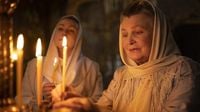Lazarus Saturday is a significant day in the Orthodox Christian calendar, celebrated on the sixth day of the sixth week of Great Lent. In 2025, this important observance falls on April 12, just one day before Palm Sunday, which marks the beginning of Holy Week. This period is a time of reflection and preparation leading up to the Resurrection of Jesus Christ, celebrated on Easter Sunday.
The events commemorated on Lazarus Saturday are rooted in the Gospel of John, specifically chapter 11, which narrates the story of Lazarus, a close friend of Jesus who died from a serious illness. Four days after Lazarus's death, Jesus approached the cave where his body lay. He instructed those present to roll away the stone sealing the entrance and prayed to God before calling out, "Lazarus! Come forth!" Miraculously, Lazarus emerged from the tomb, alive once more. This act not only demonstrated Jesus's power over death but also led many to believe in him as the Messiah.
According to Sister Tavifa from the Ioann-Precursor Monastery, the celebration of Lazarus Saturday allows the faithful to participate in the events of Christ's life, saying, "We do not just remember the events of the holiday; during the church service, we participate in the event itself, as the service introduces us to another space, to eternity, where all the Gospel events somehow continue to live in a way incomprehensible to the human mind."
Traditionally, on Lazarus Saturday, people in Russia would rise early and head to the nearest river to collect willow branches. This custom dates back to before the 1917 revolution and was part of a larger celebration known as the "willow trade" held annually in Red Square. On this day, vendors would sell icons, sweets, and toys. Upon returning home, parents would lightly strike their children with the willow branches, symbolizing good luck, health, and prosperity.
After gathering the branches, families would prepare special dishes, including buckwheat pancakes and fish pies. Sister Tavifa encourages everyone to celebrate the resurrection of Lazarus by sharing joy and blessings with those in need. She suggests attending evening services on Friday and the liturgy on Saturday morning, where the reading of the Gospel culminates in the proclamation, "Lazarus, come forth!" After the service, families often gather for a festive meal, including fish roe, which is permitted during Lent.
The article also provides a simple recipe for making buckwheat pancakes, which includes 220 grams of wheat flour, 220 grams of buckwheat flour, 500 grams of water, 5 grams of baking soda, and lemon juice. The preparation involves sifting the flour and gradually adding water while stirring. After mixing in the baking soda, the batter is cooked in a greased skillet until golden brown.
On Lazarus Saturday, there are certain activities that are encouraged, such as:
- Visiting the river to collect or purchase willow branches.
- Attending church services.
- Giving to those in need.
- Preparing festive meals, including pancakes and pies.
Conversely, there are also prohibitions on this day, which include:
- Engaging in heavy labor.
- Building or crafting.
- Sewing, knitting, or engaging in handiwork.
- Cleaning or organizing.
- Bathing.
While Lazarus Saturday is celebrated during Lent, the church allows some leniency for festive occasions. Sister Tavifa notes, "On Lazarus Saturday, those observing the fast are permitted to eat fish roe," and adds that vegetable oil and a small amount of wine are also acceptable.
As the faithful prepare for Lazarus Saturday, they extend warm wishes to one another, emphasizing themes of health, love, and happiness. Common greetings include heartfelt messages wishing others joy and a reminder of the miracle of Lazarus's resurrection, which inspires hope and peace.
Looking ahead, the following significant event in the Orthodox calendar is Easter, which in 2025 will be celebrated on April 20. This celebration, known as the Bright Resurrection of Christ, is one of the most important holidays for Christians. It symbolizes the triumph of life over death and is celebrated with various customs, including the preparation of kulich (a sweet bread) and the painting of eggs, which are often dyed red to symbolize the blood of Christ.
Interestingly, the dates for Easter can vary between different Christian denominations. In 2025, however, both Orthodox and Catholic Easter will coincide on the same day, April 20. This is due to the timing of the vernal equinox and the first full moon in both the Gregorian and Julian calendars, which will align this year.
In preparation for Easter, charitable events such as the "Light of Easter" initiative are being organized in the Khanty-Mansi Autonomous Okrug. This event encourages community members to donate non-perishable food items to help those in need, including families, elderly individuals, and children. Such acts of kindness are seen as a vital part of the Easter spirit, reflecting the message of love and giving that the holiday embodies.
As the faithful gather in churches for daily services leading up to Easter, children are also engaged in educational excursions to learn more about their faith. These activities foster a sense of community and reinforce the traditions associated with these significant religious observances.
Ultimately, Lazarus Saturday serves as a poignant reminder of the hope and renewal that is central to the Christian faith, paving the way for the joyous celebration of Easter.





